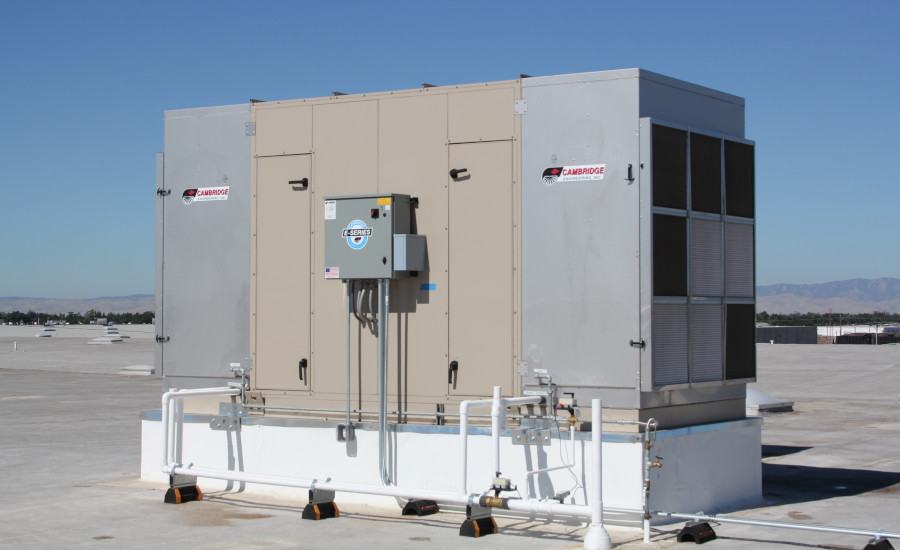Founded as a small family business in 1973, Pacific Southwest Container (PSC) started with one factory serving local businesses in Modesto, California. Three generations later, the company has grown into one of the largest privately held packaging companies in the U.S. With more than 1,000 team members and four locations, PSC creates packaging that ranges from high-volume to high-touch and standard to sophisticated. The company remains committed to investing in innovation, its people, and its craft.
Problem:
Providing proper indoor air quality during the hot summer months can be challenging for most manufacturers throughout the U.S., but, when a facility has several corrugating machines operating year-round, and it’s located in the San Joaquin Valley in Visalia, California, providing proper indoor air quality for the hard-working team members within that building is a huge challenge.
For this West Coast corrugated box manufacturer, the heat created during the manufacturing process is enough in itself to drive the temperature inside the facility to a point where worker productivity suffers. Add in the need for mechanical ventilation to provide fresh air, and now you’re introducing outside air where the temperatures during the summer can reach 100°F and higher.
Sweltering air from the outside combined with hot temperatures created via the manufacturing process creates an extremely warm facility — with no relief in sight.
How does a major West Coast corrugator provide superior IAQ for its team without breaking the bank? Direct evaporative cooling.
Solution:
The hot dry climate of the Pacific Southwest is perfect for Cambridge Engineering’s direct evaporative cooling technology. On a 104°F day,facility managers can achieve a 24° temperature depression from the outside air. That’s a “leaving-air” temperature of 75° when it’s 105° outside.
Now, that doesn’t mean your facility will be 75° during operating hours. What it does mean is that a direct evaporative solution can match the exhaust air load with 75° cool-tempered air. Mix that with the heat that corrugating machines create (and other heat-generating processes within the facility), and the facility emerges with dramatically lower air temperatures. This gives facility managers the ability to better manage their IAQ versus bringing in 105° air and mixing it with the already warm air inside a facility, ultimately resulting in in better indoor air quality.
Results:
|
Date |
Time |
Discharge Temperature °F |
Outdoor Temperature °F |
Temperature Depression °F |
|
08/14/19 |
12:00:00.0 |
73.8 |
88 |
14.2 |
|
08/14/19 |
14:00:00.0 |
77.3 |
94 |
16.7 |
|
08/14/19 |
16:00:00.0 |
80.1 |
100 |
19.9 |
|
08/14/19 |
17:00:00.0 |
80.1 |
102 |
21.9 |
|
|
|
|
|
|
|
08/15/19 |
12:00:00.0 |
73.2 |
90 |
16.9 |
|
08/15/19 |
14:00:00.0 |
78.0 |
97 |
19.0 |
|
08/15/19 |
16:00:00.0 |
80.6 |
102 |
21.4 |
|
08/15/19 |
17:00:00.0 |
80.8 |
104 |
23.2 |
|
08/15/19 |
18:00:00.0 |
80.8 |
103 |
22.2 |
|
|
|
|
|
|
|
08/16/19 |
12:00:00.0 |
75.9 |
93 |
17.1 |
|
08/16/19 |
14:00:00.0 |
78.7 |
98 |
19.3 |
|
08/16/19 |
16:00:00.0 |
80.8 |
103 |
22.2 |
|
08/16/19 |
17:00:00.0 |
80.8 |
104 |
23.2 |
|
08/16/19 |
18:00:00.0 |
79.4 |
104 |
24.6 |
Direct evaporative cooling:
The Cambridge E-Series DEC unit is engineered to provide cool, fresh, tempered air for facilities to create a more comfortable and productive work environment while using up to 70% less energy than conventional mechanical cooling systems.
The E-Series unit has 10 models, supplying 10,000-80,000 cfm of outside air. These compact units are built in modular sections with a continuous perimeter base frame. They can be placed on a rooftop or grade mounted and ship in one section for quick and easy installation, saving both time and money.
Industrial applications for the E-Series (direct evaporative cooling) include:
Commercial
- Warehouse/Distribution;
- Aviation;
- Sports Arenas;
- Greenhouses;
- Agriculture; and
- Municipality.
Industrial
- Manufacturing;
- Warehouse;
- Waste Water Treatment; and
- Foundries.
Evaporative cooling systems have a number of benefits. They use only a fraction of the energy of typical compressor-based cooling systems. Highly-efficient evaporative cooling systems can reduce energy use by 70%. (The actual savings will vary with the type of evaporative system and climate.) For dry climates, where evaporative cooling can meet the entire load, they dramatically reduce peak demand. When evaporative cooling is used with supplemental DX cooling, it can reduce the required amount of DX cooling; moreover, since they use 100% outside air for cooling, the right evaporative cooling system can also improve indoor air quality.



